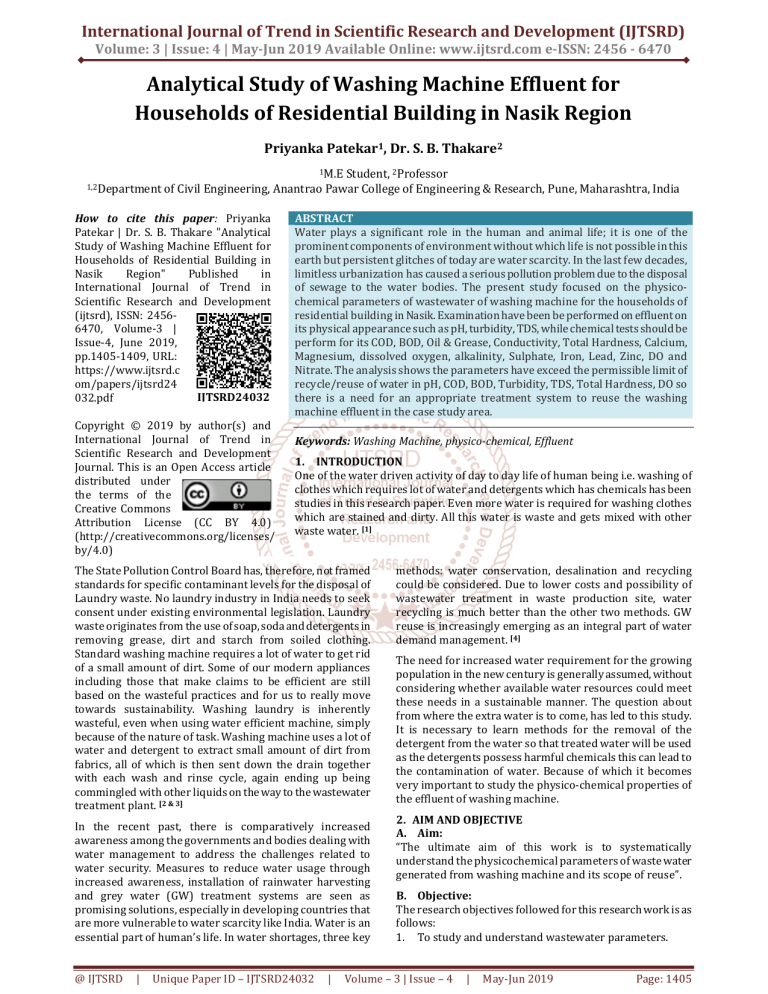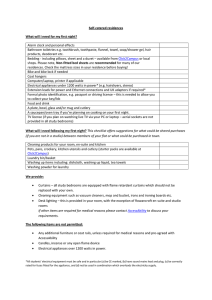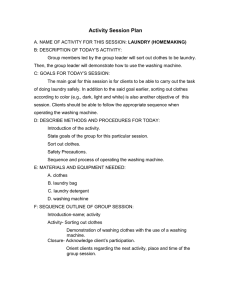
International Journal of Trend in Scientific Research and Development (IJTSRD)
Volume: 3 | Issue: 4 | May-Jun 2019 Available Online: www.ijtsrd.com e-ISSN: 2456 - 6470
Analytical Study of Washing Machine Effluent for
Households of Residential Building in Nasik Region
Priyanka Patekar1, Dr. S. B. Thakare2
1M.E
1,2Department
Student, 2Professor
of Civil Engineering, Anantrao Pawar College of Engineering & Research, Pune, Maharashtra, India
How to cite this paper: Priyanka
Patekar | Dr. S. B. Thakare "Analytical
Study of Washing Machine Effluent for
Households of Residential Building in
Nasik
Region"
Published
in
International Journal of Trend in
Scientific Research and Development
(ijtsrd), ISSN: 24566470, Volume-3 |
Issue-4, June 2019,
pp.1405-1409, URL:
https://www.ijtsrd.c
om/papers/ijtsrd24
IJTSRD24032
032.pdf
Copyright © 2019 by author(s) and
International Journal of Trend in
Scientific Research and Development
Journal. This is an Open Access article
distributed under
the terms of the
Creative Commons
Attribution License (CC BY 4.0)
(http://creativecommons.org/licenses/
by/4.0)
ABSTRACT
Water plays a significant role in the human and animal life; it is one of the
prominent components of environment without which life is not possible in this
earth but persistent glitches of today are water scarcity. In the last few decades,
limitless urbanization has caused a serious pollution problem due to the disposal
of sewage to the water bodies. The present study focused on the physicochemical parameters of wastewater of washing machine for the households of
residential building in Nasik. Examination have been be performed on effluent on
its physical appearance such as pH, turbidity, TDS, while chemical tests should be
perform for its COD, BOD, Oil & Grease, Conductivity, Total Hardness, Calcium,
Magnesium, dissolved oxygen, alkalinity, Sulphate, Iron, Lead, Zinc, DO and
Nitrate. The analysis shows the parameters have exceed the permissible limit of
recycle/reuse of water in pH, COD, BOD, Turbidity, TDS, Total Hardness, DO so
there is a need for an appropriate treatment system to reuse the washing
machine effluent in the case study area.
Keywords: Washing Machine, physico-chemical, Effluent
1. INTRODUCTION
One of the water driven activity of day to day life of human being i.e. washing of
clothes which requires lot of water and detergents which has chemicals has been
studies in this research paper. Even more water is required for washing clothes
which are stained and dirty. All this water is waste and gets mixed with other
waste water. [1]
The State Pollution Control Board has, therefore, not framed
standards for specific contaminant levels for the disposal of
Laundry waste. No laundry industry in India needs to seek
consent under existing environmental legislation. Laundry
waste originates from the use of soap, soda and detergents in
removing grease, dirt and starch from soiled clothing.
Standard washing machine requires a lot of water to get rid
of a small amount of dirt. Some of our modern appliances
including those that make claims to be efficient are still
based on the wasteful practices and for us to really move
towards sustainability. Washing laundry is inherently
wasteful, even when using water efficient machine, simply
because of the nature of task. Washing machine uses a lot of
water and detergent to extract small amount of dirt from
fabrics, all of which is then sent down the drain together
with each wash and rinse cycle, again ending up being
commingled with other liquids on the way to the wastewater
treatment plant. [2 & 3]
In the recent past, there is comparatively increased
awareness among the governments and bodies dealing with
water management to address the challenges related to
water security. Measures to reduce water usage through
increased awareness, installation of rainwater harvesting
and grey water (GW) treatment systems are seen as
promising solutions, especially in developing countries that
are more vulnerable to water scarcity like India. Water is an
essential part of human’s life. In water shortages, three key
@ IJTSRD
|
Unique Paper ID – IJTSRD24032
|
methods: water conservation, desalination and recycling
could be considered. Due to lower costs and possibility of
wastewater treatment in waste production site, water
recycling is much better than the other two methods. GW
reuse is increasingly emerging as an integral part of water
demand management. [4]
The need for increased water requirement for the growing
population in the new century is generally assumed, without
considering whether available water resources could meet
these needs in a sustainable manner. The question about
from where the extra water is to come, has led to this study.
It is necessary to learn methods for the removal of the
detergent from the water so that treated water will be used
as the detergents possess harmful chemicals this can lead to
the contamination of water. Because of which it becomes
very important to study the physico-chemical properties of
the effluent of washing machine.
2. AIM AND OBJECTIVE
A. Aim:
“The ultimate aim of this work is to systematically
understand the physicochemical parameters of waste water
generated from washing machine and its scope of reuse”.
B. Objective:
The research objectives followed for this research work is as
follows:
1. To study and understand wastewater parameters.
Volume – 3 | Issue – 4
|
May-Jun 2019
Page: 1405
International Journal of Trend in Scientific Research and Development (IJTSRD) @ www.ijtsrd.com eISSN: 2456-6470
2.
To study scope of reuse of waste water.
3. LITERTURE REVIEW
A literature review of scholarly articles, books, dissertations,
conference proceedings and other resources which are
Sr.
No.
1.
2.
3.
4.
relevant to the study of Laundry effluent, carried out to set
the background on what has been explored on the topic so
far.
Table No.1: Characteristics of Laundry effluent from Various Research Paper
Remarks
Year of
Tittle
Characteristics of
Publication
Laundry Effluent
Commercial Laundry Water Characterization by J. K.
2014
pH
Braga and M. B. A. Varesche
Total Alkalinity
COD
TSS
Nitrate
Nitrite
Sulphate
Sulphide
Characterization of domestic gray water from point
2014
pH
source to determine the potential for urban residential
EC
reuse by Golda A. Edwin Et. al
Hardness
BOD 5
COD
DO
TS
TSS
Nitrate
Nitrite
Study of physico-chemical characteristics of domestic
2015
pH
Wastewater in Vishnupuri, Nanded, India by Sonune NA
BOD
Et. al
COD
Ammonical Nitrogen
Nitrate
Phosphate
TDS
TSS
A Study on Characterization & Treatment of
2017
Temperature
Laundry Effluent
pH
By Prof Dr K N Sheth Mittal Patel
COD
BOD
SS
TDS
Oil & Grease
Value
5.6
25.9
1710
80
8.4
2.1
21.1
0.2
9.1
641.6
721
186.5
1545.8
N.D
586
141.2
0.3
0.2
7–8
56 – 96
180 – 300
129 – 146
74 – 181
0.4 – 2.1
1228 – 1440
43 – 65.43
30 – 34
7.88 – 10.32
376 – 910
230 – 625
445 – 1550
640 - 1455
3-6
4. METHODOLOGY
Figure No. 1: Overall Methodology Process
@ IJTSRD
|
Unique Paper ID – IJTSRD24032
|
Volume – 3 | Issue – 4
|
May-Jun 2019
Page: 1406
International Journal of Trend in Scientific Research and Development (IJTSRD) @ www.ijtsrd.com eISSN: 2456-6470
5. PHYSICO-CHEMICAL PARAMETERS OF WASHING MACHINE EFFLUENT
A. Case Study Details
Building Name
Akshar Estate
Address
Total No of flats
Kathe Lane, Dwarka, Nasik
16
Number of Flats Taken for Study
Data Collection Period
10
March – April 2019
B. Case Study Location
Nashik (formerly Gulshanabad) is an ancient holy city in the northwest region of Maharashtra in India. Situated on the banks of
Godavari River (Ganges of the South) and located about 190 km north of state capital Mumbai. The latitude and longitude of
study area is 19°80ʹ69ʺ and 73°77 ʹ69 ʺ.
Figure No. 2: Showing Map of Maharashtra & Study Area
C. Case Study Survey
Table No. 2: Data Collected from Survey
Approximate
Capacity
Process of Cleaning
Water Required
Sr.
No.
Type of Washing
Machine
1.
Fully Automatic
11
130
Wash + Rinse + Power Spin
2.
Fully Automatic
Fuzzy Logic
6.5
80
Air dry + Inlets + Temp.+ Water + Wash + Rinse +
Spin + Delay
3.
Semi-Automatic
7
90
Wash + Rinse + Spin
4.
Semi-Automatic
6
75
Wash + Rinse + Spin
5.
Fully Automatic
6.5
80
Wash + Rinse + Spin + Air Dry + Program
6.
Fully Automatic
7.5
100
Active Wash + Wash + Rinse + Power Spin
7.
Fully Automatic
6.5
80
Soak + Wash + Rinse + Spin
8.
Fully Automatic
6.2
80
Water + Wash + Rinse + Spin + Air Dry + Program
9.
Fully Automatic
6
85
Soak + Wash + Rinse + Spin
10.
Semi-Automatic
8.5
110
Wash + Rinse + Spin
@ IJTSRD
|
Unique Paper ID – IJTSRD24032
|
Volume – 3 | Issue – 4
|
May-Jun 2019
Page: 1407
International Journal of Trend in Scientific Research and Development (IJTSRD) @ www.ijtsrd.com eISSN: 2456-6470
Figure No. 3: Photos While Carrying Out the Survey
D. Method Adopted for Analysis
All the water quality parameters studied in the project are specified with the method used to determine the parameters are
mentioned in below Table.
Table No. 3: Physico-chemical Parameters and Methods Adopted for the Analysis
Sr. No. Analysis Parameters
Method used
01
pH
pH meter, IS: 3025 (part – 11 – 2): Reaff. 2012
02
COD
IS: 3025 (part – 58): Reaff. 2014
03
BOD
IS: 3025 (part – 44): Reaff. 2014
04
Oil and Grease
IS: 3025 (part – 39- 5): Reaff. 2014
05
Turbidity
Nephelometer, IS: 3025 (part – 10): Reaff. 2012
06
Conductivity
Conductivity meter IS: 3025 (part – 14): Reaff. 2013
07
Total Dissolved Solids Gravimetric Metrhod, IS: 3025 (part – 16): Reaff. 2012
08
Total Hardness
Titrimetric Method, IS: 3025 (part – 21- 2): Reaff. 2014
09
Calcium
Titrimetric Method, IS: 3025 (part – 40- 5): Reaff. 2014
10
Magnesium
Titrimetric Method, IS: 3025 (part – 46- 6): Reaff. 2014
11
Total Alkalinity
Titrimetric Method IS: 3025 (part – 23): Reaff. 2014
12
Sulphate
Spectrometer IS: 3025 (part – 24- 4): Reaff. 2014
13
Iron
Spectrometer IS: 3025 (part – 53- 6): Reaff. 2014
14
Lead
Atomic Absorption, APHA 3111 - D
15
Zinc
Atomic Absorption, APHA 3111 - D
16
Dissolved Oxygen
Atomic Absorption IS: 3025 (part – 44): Reaff. 2003
17
Nitrate
IS 3025 (Part 34): Reaff. 2014
E. Analysis of Physico-chemical Parameters
The sample analyses of the collected effluent from the ten households are represented in to the tabular form in following
section.
Table No. 4: Physico-chemical analysis of Effluent of Case Study Area
Sr. No.
1
2
3
4
5
6
7
8
9
10
11
12
13
14
15
16
17
@ IJTSRD
|
Unique Paper ID – IJTSRD24032
Analysis Parameters
Mean
pH
COD
BOD
Oil and Grease
Turbidity
Conductivity
TDS
Total Hardness
Calcium
Magnesium
Total Alkalinity
Sulphate
Iron
Lead
Zinc
Dissolved Oxygen
Nitrate
9.1
1543.0
183.1
2.5
107.5
640.4
708.5
612.0
4.1
1.3
37.1
25.7
0.8
<0.003
<0.01
ND
0.2
|
Volume – 3 | Issue – 4
|
May-Jun 2019
Page: 1408
International Journal of Trend in Scientific Research and Development (IJTSRD) @ www.ijtsrd.com eISSN: 2456-6470
F. Physicochemical Parameters Compared with the Standards
The physicochemical composition of washing machine effluent samples was statistically analysed between march 2019 to April
2019 and the results are presented in the form of acceptability or class of the parameter based on Water recycle/reuse
standards based on protection of human health and the environment and suitability for the intended reuse application in below
section.
Table No. 5: Washing machine Quality Classification based on Recycle/Reuse Standards
Sr. No.
Analysis Parameters
Mean Value
Acceptability
01
pH
9.1
Above the permissible limit
02
COD
1543.0
Above the permissible limit
03
BOD
183.1
Above the permissible limit
04
Oil and Grease
2.5
Doubtful
05
Turbidity
107.5
Above the permissible limit
06
Conductivity
640.4
Doubtful
07
TDS
708.5
Within Permissible limit
08
Total Hardness
612.0
Above the permissible limit
09
Calcium
4.1
Within Permissible limit
10
Magnesium
1.3
Within Permissible limit
11
Total Alkalinity
37.1
Doubtful
12
Sulphate
25.7
Within Permissible limit
13
Iron
0.8
Within Permissible limit
14
Lead
<0.003
Within Permissible limit
15
Zinc
<0.01
Within Permissible limit
16
Dissolved Oxygen
ND
Insufficient to be in permissible limit
17
Nitrate
0.2
Within Permissible limit
6. CONCLUSION
The characteristics of domestic washing machine wastewater were evaluated using wastewater samples from ten selected
households of study area. The samples were analysed for the physical and chemical characteristics of the water. The
parameters examined were: pH, Turbidity, TDS, COD, BOD, Oil & Grease, Conductivity, Total Hardness, Calcium, Magnesium,
Alkanity, Sulphate, Iron, Lead, Zinc, DO and Nitrate.
The research showed that the quality of grey water with respect to COD, BOD, TDS, turbidity and total hardness requires
adequate treatment prior to household reuse. With regard to the trace and heavy metal contents, no further treatment is
required.
Reference
[1] Shirazi MMA, Kargari A, Shiraz MJA (2012) Direct
contact membrane distillation for seawater
desalination. Desalin Water Treat 49: 368-375. Link:
https://goo.gl/gvo7AS
[2] Nemerow Nelson Leonard, Dasgupta Avijit, ”Industrial
and Hazardous Waste Treatment”, van Nostrand
Reinhold, 1991
[3] Dolnicar S, Schafer AI (2009) Desalinated versus
recycled water: public perceptions and profi les of the
accepters. J Environ Manag 90: 888-900.
Link:https://goo.gl/r6RDEs
[4] Lu W, Leung AYT (2003) A preliminary study on
potential of developing shower/laundry wastewater
reclamation and reuse system. Chemosphere 52: 14511459. Link: https://goo.gl/2kYyQn.
[5] Shirazi MMA, Kargari A, Shiraz MJA (2012) Direct
contact membrane distillation for seawater
desalination. Desalin Water Treat 49: 368-375. Link:
https://goo.gl/gvo7AS
[6] Dolnicar S, Schafer AI (2009) Desalinated versus
recycled water: public perceptions and profi les of the
accepters. J Environ Manag 90: 888-900. Link:
https://goo.gl/r6RDEs
[7] Lu W, Leung AYT (2003) A preliminary study on
potential of developing shower/laundry wastewater
reclamation and reuse system. Chemosphere 52: 14511459. Link: https://goo.gl/2kYyQn
@ IJTSRD
|
Unique Paper ID – IJTSRD24032
|
[8] Wendland C, Albold A (2010) Sustainable and Costeffective Wastewater Systems for Rural and Peri-urban
Communities up to 10,000 Population Equivalents:
Guidance Paper. Women in Europe for a Common
Future
(WECF),
Munch,
Germany.
Link:
https://goo.gl/Kv4Neq
[9] Pakula C, Stamminger R (2010) Electricity and water
consumption for laundry washing by washing machine
worldwide. Energy Effi c 3: 365-382. Link:
https://goo.gl/FSRrSJ
[10] Ciabatti I, Cesaro F, Faralli L, Fatarella E, Tognotti F
(2009) Demonstration of a treatment system for purifi
cation and reuse of laundry wastewater. Desalination
245: 451-459. Link: https://goo.gl/wbyLPt
[11] Dolnicar S, Saunders C (2005) Marketing recycled
water: review of past studies and research agenda.
Integrated concepts in water recycling. Wollongong:
University of Wollongong, Australia. 181-92. Link:
https://goo.gl/e2Xut2
[12] Ngo HH, Chuang H, Guo WS, Ho DP, Pham TTN, et al.
(2009) Resident’s strategy survey on a new end use of
recycled water in Australia. Desalination Water
Treatment 11: 93-97. Link: https://goo.gl/ps92VH
[13] Pham TTN, Ngo HH, Guo WS, Dang HPD, Mainali B, et al.
(2011) Response of community to the public use of
recycled water for washing machine: a case study in
Sydney, Australia. Resource Conservation Recycling 55:
535-540. Link: https://goo.gl/utc1kc
Volume – 3 | Issue – 4
|
May-Jun 2019
Page: 1409





